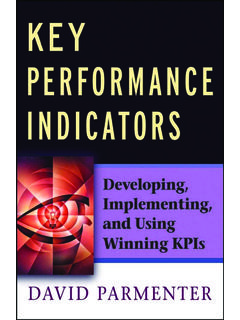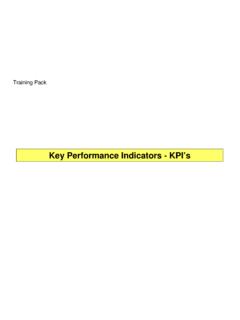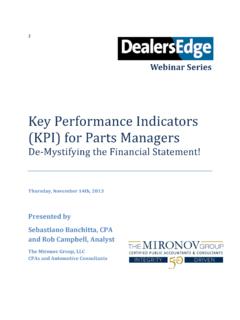Transcription of Introduction To Key Performance Indicators For …
1 - ESS Marketing Pty Ltd - ACN: 078 451 439 Paper 260903 Page 1 OPERATING A SUCCESSFUL BUSINESS Introduction TO KEY Performance Indicators FOR SMES (SMALL/MEDIUM ENTERPRISES) Paper CONTENTS Page 1. What Are Key Performance Indicators ? (KPIs) 2 2. Definitions 3 3.
2 Understanding The Financial State Of Health Of The Business 3 4. Why Measure? 3 5. The Balanced Scorecard (Kaplan & Norton) 5 6. Focus On Long Term Economic Value And Strategic Benefits To The Organisation 5 - ESS Marketing Pty Ltd - ACN: 078 451 439 Paper 260903 Page 2 OPERATING A SUCCESSFUL BUSINESS Introduction TO KEY Performance Indicators FOR SMES (SMALL/MEDIUM ENTERPRISES) Paper 1.
3 What Are Key Performance Indicators ? (KPIs) 1. A new paradigm of Performance measure has been adopted by many SMEs. This is based on identifying what the business does in terms of levels of processes and attaching Key Performance Indicators to those processes. The recording and analysis of the KPIs should significantly contribute to the achievement of business goals. 2. Key Performance Indicators tell businesses: how well they provide services how long they take to process customer requests their product delivery Performance how much time they spend fixing mistakes These are all part of a trend to broaden what businesses measure.
4 3. Key Performance Indicators are those critical measures which ultimately determine profitability and shareholder value. 4. The traditional Profit & Loss Account, Balance Sheet, Statement of Source and Application of Funds, Periodic Financial Accounts are not enough to effectively manage businesses which are seeking to survive and add shareholder/owner value. 5. Management needs additional timely information, much of which is not traditional Financial Data, if they are going to effectively manage their businesses.
5 6. The information must be able to be understood by all levels of staff so that they can continually measure their actual Performance against the business s pre-determined targets. - ESS Marketing Pty Ltd - ACN: 078 451 439 Paper 260903 Page 3 2. Definitions 1. A Performance indicator (PI) measure is a measure of the behaviour of a business process. 2. A Key Performance indicator (KPI) is a Performance indicator clearly aligned with a corporate/business objective. 3. Understanding The Financial State Of Health Of The Business 1.
6 Understanding the state of the financial health of a business is a very important issue relating to business survival. There is a strong similarity between physical fitness and the health of a business. The Cashflow of a business can be likened to the blood circulating through a person. If there is haemorrhaging in the flow the consequences are swift and predictable. Equally, the level of investment in Stocks, Debtors and non essential cash expenditure within a business can be compared with the degree of fat in a person, clogging the system and preventing it from working efficiently.
7 2. Business people are seeking the appropriate tools to accurately measure the Performance of their business in the critical areas of Profitability and Return on Net Assets. 3. This enables them to identify the critical strengths and weaknesses of their business and to evaluate the impact of their future business strategies. 4. The use of Key Performance Indicators will greatly assist in this diagnostic review of the financial health of the business. 4. Why Measure? 1. Investors are putting greater pressure on company management s to be able to demonstrate that management strategies are creating value and that scarce resources are being directed into the most efficient use consistent with the business s goals.
8 2. The same problem faces owner/managers of SMEs. How can they be sure that they are running their business s in ways which actually enhance it s value? - ESS Marketing Pty Ltd - ACN: 078 451 439 Paper 260903 Page 4 3. Business organisations and financiers are demanding more effective Performance measuring systems that will not only enhance their Performance levels, but give them a competitive edge. 4. Performance , whether in Government, Business, Investment or Sport should be judged against objective criteria.
9 5. Traditionally, Performance Management Systems have had a financial bias and only produced information for management. As a result, they have ignored the key issues of linking operational Performance to the Business s strategic objectives and communicating these objectives and Performance results to all levels of the organisation, not just management. 6. Performance measurement standards need improvement in many SMEs. There have been two very different schools of thought as to how this can be achieved; One school advocates that traditional financial measurements should be revised and improved to make them more relevant and effective within a modern business environment.
10 The other urges that businesses should ignore financial measures altogether and focus instead on operational parameters. Both schools of thought accept that no single measure can provide a clear picture of a business. The complexity of managing a business today requires managers to be able to view Performance in several areas simultaneously. 7. A concept has been developed by US academics, Robert Kaplan and David Norton, which they have called The Balanced Scorecard . This measures corporate Performance by addressing four basic questions.








